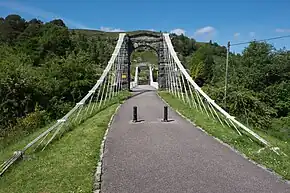
The taper suspension bridge (also known as the taper principle) is a bridge design patented by James Dredge in 1836.[1]
The principle
On a conventional suspension bridge the whole deck is suspended on vertical cables, rods or chains from a single cable or chain slung between two supporting towers. The taper suspension bridge that James Dredge devised in the early nineteenth century differs from the conventional suspension bridge design in that it is, in effect, a double cantilever bridge. Each of the opposing cantilever systems are self-supporting. The cantilever half-deck structure of each cantilever is suspended on angled chains from a tapered main chain that hangs from the top of the tower and is attached to the outer end of the half-deck. The main chain taper is achieved by incrementally reducing the number of links stacked across the chain width the further it gets from the support tower.[2]
The advantage of the taper system is that the resulting design is cheaper to build than a conventional suspension bridge of the period because it uses less iron and is quicker to build.[1]
Surviving examples
Of the 36 known examples of bridges started or completed by Dredge using this design, 7 are known to have survived.[1]
| Name | Date built | Original location | Current location | Span | Image |
|---|---|---|---|---|---|
| Victoria Bridge | 1836 | Bath, England | As built | 150 feet (46 m) |  |
| Glenarb Bridge | 1844 | River Blackwater, Caledon, Northern Ireland | Relocated to Caledon[3] |  | |
| Caledon Estate Bridge | 1845 | River Blackwater, Caledon, Northern Ireland | As built | ||
| Stowell Park Bridge | 1845 | Pewsey, Wiltshire, England | As built |  | |
| Second Moyola Park Bridge | 1847 | Castledawson, Northern Ireland | As built | ||
| Bridge of Oich | 1854 | River Oich, Aberchalder, Scotland | As built | 155 feet 6 inches (47.40 m)[2] |  |
| General's Well Bridge[4] | 1853[5] | River Ness, Ness Islands. Inverness[4] | Relocated to Ness Islands Railway, Whin Park, Inverness | 97 feet (30 m)[4] |  |
References
- 1 2 3 "James Dredge, Senior". Grace's Guide. Grace's Guide. Retrieved 2016-07-16.
- 1 2 "Oich, Bridge Of Oich". The online catalogue to Scotland’s archaeology, buildings, industrial and maritime heritage. Historic Environment Scotland. Retrieved 2016-07-16.
- ↑ "The Dredge Bridge". Blackwater Regional Partnership. Blackwater Region. Retrieved 2016-07-18.
- 1 2 3 Paxton, Roland; Shipway, Jim (2007). Civil Engineering Heritage Scotland - Highlands and Islands. Thomas Telford. ISBN 978-0-7277-3488-4.
- ↑ "Ness Islands Footbridges". Grace's Guide to British Industrial History. Grace's Guide. Retrieved 2016-07-18.